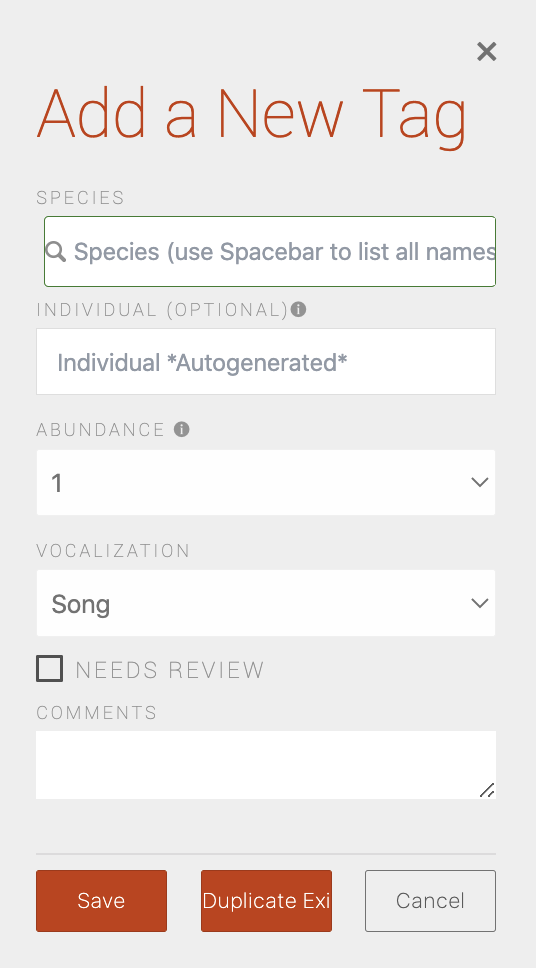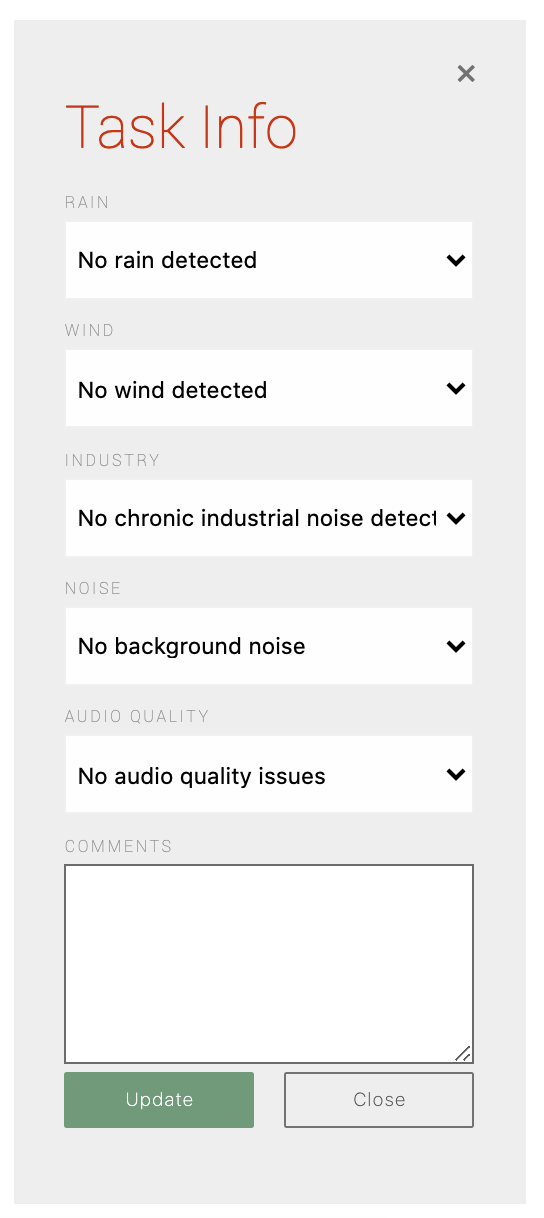Index
4.3 Acoustic tagging methods

The acoustic processing methods in WildTrax are designed to emulate avian point counts and are an amalgamation of recommendations provided by the Bioacoustic Unit, the Boreal Avian Modelling project and Environment and Climate Change Canada based on standard methodologies.
The processing method is chosen either during the upload stage of the media or by uploading tasks to a project and is based on two values: the processing length of the recording and the "count-removal" method type.
The first component is the length of time in seconds. The easiest way to think of count-removal is when you tag an individual of a species and then want to "remove it" from the rest of tagging. WildTrax will automatically implement this limit depending on the method you choose. Here we define the limit at the individual level, like OVEN 1 and OVEN 2. There are currently options for a tag per minute limit (1SPM), a tag per task limit (1SPT) or an unlimited number of tags (None).
Individuals and abundance

If your project requires, it's important to ensure individuals are tracked consistently through each interval of the processing method. This way all individuals are annotated correctly.
The number of individuals you can distinguish and track is dependent on multiple factors and these can either facilitate or hinder your ability. Accuracy in individual tagging increases when:
- individuals are territorial (separated spatially),
- individuals are sedentary (not moving or not appearing to move via spectrogram attributes such as amplitude or channel),
- individuals have unique song attributes or singing behaviour,
- the species richness on the recording is low (there are no masking signals),
- abiotic signals on the recording are low (there is no noise interference)
It becomes to difficult to tag distinct individuals especially when certain species have life history traits or behaviour leading them to be abundant. Alternatively, you can tag multiple individuals of a species at once and change the abundance value to reflect the count of individuals of that species in the tag. You can also use the TMTT (too many to tag) option to indicate an uncountable numbers of individuals of the species within the bounds of the tag.
Increasing the abundance value should only be used when you're certain you can't tell individuals apart. If you're unsure, it's recommended to always use the more conservative estimate. Practicing also helps!

Amphibian abundance
-
CI1: Individuals can be counted, there is space between the calls
-
CI2: Calls of individuals can be distinguished but there is overlap
-
CI3: Full chorus, calls are constant, continuous and overlapping
Vocalization type
Animals can produce many different vocalizations. In the current version of WildTrax, vocalizations are categorized as either song, call or non-vocal and for ultrasonic species call+feeding buzz.
Song is loosely defined as the male, territorial, mate-attracting vocalization produced by passerine (songbird) males and some non-passerine species. In many bird studies, passerine song is used to estimate the density and population size of a species and is a reliable metric. This is because a male passerine generally sings in the territory it's occupying.
-
Ovenbird (Seiurus aurocapillus) song
-
Black-throated Green Warbler (Setophaga virens) multiple song types
Calls are any vocalization made by individuals where the sex cannot be distinguished and / or the vocalization is not for mate-attraction. Some example of this include the simpler and less melodious vocalizations typical of some non-passerines as well as vocalizations like alarm calls, begging calls, etc.
Exceptions can and do exist in the natural world. For example, despite being passerines, all corvid vocalizations are calls, as both males and females can produce them. Conversely, the Yellow Rail (YERA) is a non-passerine but the primary vocalization (“tik-tik tik-tik-tik”) is always entered as song since it is for territorial delineation and mate attraction, and the female does not produce the vocalization.
Flight calls are other unique vocalizations given by birds which WildTrax differentiates these as they come from trigger-based recordings and separate study designs from scheduled-based recordings. It's possible with certain families like the thrushes (Turdidae) and blackbirds (Icteridae) to identify these call signals to species.
-
Night flight call notes
-
White-throated Sparrow (Zonotrichia leucophrys) call notes
-
Swainson's Thrush (Catharus ustulatus) call notes
Non-vocal vocalizations are mechanical sounds made by a species, such as winnows, bleats, drums or booms that are not made by the vocal tract.
-
Wilson's Snipe (Gallinago delicata) winnowing
-
Yellow-bellied Sapsucker (Sphyrapicus varius) drumming
Call+Feeding Buzz are the rapid series of calls produced to capture prey by echolocating species.
-
Little Brown Bat (Myotis lucifugus) feeding buzz
Depending on the taxa that you're studying, you may want to use these categories differently than how WildTrax suggests. These recommendations, while imperfect, reflect common practices and help to standardize vocalization metadata. Nevertheless, the system is agnostic to vocalization type standards and is a proponent in making the system as flexible as possible. If you have a recommendation or suggestion on how to help develop this standard, email WildTrax Info.
Confidence and classifying unknowns
 box helps to filter tags for verification.
box helps to filter tags for verification.
- The signal is clear but it cannot be identified
- The signal is too degraded, faint or masked
- The signal is a non-descript short call note or alarm call
As unknowns are detected they should be placed into sub-categories as much as possible to refine how another observer or project administrator will identify it later on. For example, a triller should be identified as UNTL instead of UNPA (unknown passerine) or UNKN (unknown). Be conservative in the categorization process – if you’re not sure, always revert to the more basal category, like UNKN. Some signals are too faint, degraded or masked that they're likely not identifiable. The threshold of signal identification is dependent on many factors including amplitude, signal complexity, observer skill and how much the signal is masked or overlapped by others in the recording. There are certain species complexes that cross over families and genera of species – in this case the more conservative unknown code should be used.
Faint, generic and indistinct call notes tend to be overlooked when conducting community census tagging as they do not provide much information to the occupancy or detectability of that individual over time; the BU uses standardized replication at each station to account for these tendencies.
Once a tag is labeled as Needs Review, the panel in species verification will also change to yellow. See species verification for more details.
Abiotic signals and bad weather
ARUs don't discriminate noise sources, including geophonic (e.g. wind and rain) and anthropogenic (e.g. human produced) sounds. Assessing, tagging and recording these noise sources is important as they can affect species detection depending on the frequency range and amplitude of the abiotic signal.
and anthropogenic (e.g. human produced) sounds. Assessing, tagging and recording these noise sources is important as they can affect species detection depending on the frequency range and amplitude of the abiotic signal.
For example, certain recorders can be placed very close to industrial features such as compressor stations where noise is almost constant throughout the entire recording due to motors, fans, engines, etc. Others can be located near busy roads where noisy cars may occasionally pass by. All these sounds have distinct acoustic signatures that can identified and tagged on a spectrogram. Noise sources can also be biotic such as bugs flying past the microphones.
Keep in mind that the assessment of noise can be made both through frequency and/or amplitude. Even faint broad-scale sounds will affect species detection, whereas a loud low-frequency sound can also trick the ear into missing biotic signals.
WildTrax defines two different noise source types: intermittent and chronic. They describe whether a noise source is occurring consistently throughout a recording or if the noise source is temporary. Intermittent noise can be traffic from a highway, a plane flying overhead or deterrents from an industrial site. Chronic noise sources are classified into four broad categories:
- Rain
- Wind
- Industry; chronic industrial noise such as processing facilities, mines, oil and gas features, etc.
- Background; the background noise category describes chronic noise that do not fall into the other categories such as flowing water, thunder or insect swarms.
Assessing the noise on a recording involves two steps:
- tagging the noise on the spectrogram
- estimating the average noise level in the task info panel
Tagging abiotic noises according to their detection interval on a recording, this will typically be in the standard one-minute interval just as you would for birds and amphibians.
Abiotic tags should always be a minimum of 5 seconds if the source is continuous, or the maximum duration of the event, in the case of say a car driving past. Tags should also be made in the frequency range of the event (i.e. heavy winds may box the maximum dimensions of the spectrogram on the y-axis). WildTrax uses four-letter codes similar to AOS designations to record rain, wind, chronic industrial, intermittent anthropogenic and other background noise.
All ARUs produce a certain amount of internal static – you can record the static to indicate a possible equipment failure. Older models of ARUs have a lower signal-to-noise ratio which can produce the increase in static.
The weather panel also provides a way of making assessments of the weather conditions to determine whether or not they are appropriate for processing. WildTrax will develop recommendations for this in the near future.